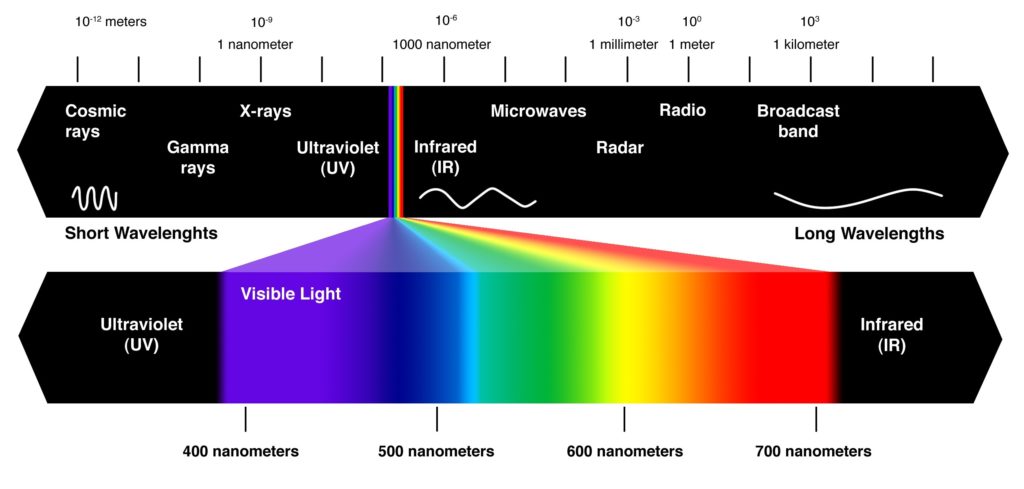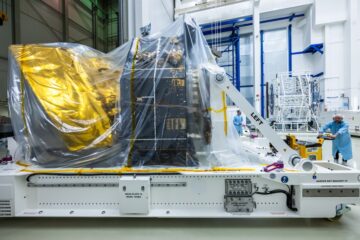It’s International Day of Light today! In honour of this international event, we at Astronotes decided it would be an excellent chance to explain how light could be the future for our climate and the answer to our questions about how we can power our planet!
What is light?
Light is a wave. Light (or visible light: the light we can see with our unaided human eyes) is the visible part of electromagnetic radiation on the electromagnetic spectrum. The light that we can see, and all of its colour, is only a tiny portion of the spectrum!

In physics, all of these sources son the electromagnetic spectrum are “light” – we just can’t see them with our eyes. To help with this, telescopes have been developed that have the ability to see what we cannot. For example, this image below compares what the Hubble Space Telescope can show us in visible light, versus what the James Webb Telescope might see in the infrared after it is launched.

Similarly, the Chandra X-Ray Telescope allows us to see what our eyes cannot – such as this momentous image of M87. The X-ray image on the left shows a jet from a central engine, while to right a view at radio wavelengths this is revealed as a supermassive black hole as seen by the Event Horizon Telescope.

The wonders of light, with the assistance of modern technology, can now be appreciated in all of its glory. It’s amazing what our eyes can miss even if we are looking at the same object.

Of course, our main light source on Earth is the sun. The sun powers cells in plants to photosynthesise, produce sugar and feed all the living things on our planet. However, the light that we can see is only about 40% of the light is producing; the rest is mainly Infrared with some ultraviolet light too.
However it is the visible light that proves the most useful to our needs on earth.
How does solar power work?
Light is also energy. Light is made of of particles called photons – these have no mass and travel incredibly quickly. It takes a photon roughly 8 minutes to get from the surface of the sun to us on Earth. Photons travel at the speed of light you see! So these particles have a lot of energy to be harnessed.
If we look back to the electromagnetic spectrum we can see that the frequency of infrared light is lower than visible light – this means it has much lower energy. On the other hand, ultraviolet has plenty of energy but our sun’s light is only about 10% ultraviolet. This means, if we wanted to harness the light of our central star we would need a device that captures visible light and turns it into useful energy – like electricity. Behold! The solar cell!

Solar cells have been created to turn the light from the sun into electrical energy for us to power our homes, cars, phones and more. Solar cells in solar panels work by knocking electrons free from atoms, creating a flow of electricity which we can harness and use. Think of the light particles as the white ball in snooker – the other balls are the electrons being freed from their atoms! A key ingredient for this is the element silicon, which manufacturers give either a positive or negative charge – this creates a current. Metal around the edges of the panels collect the electricity and transfer it into wires. Boom! You have a tiny electricity producing factory. Amazing what light can do!

Can we use it to power our planet?
It is estimated that the energy the sun shines on our planet in one hour could power all of our cities, towns, lights, homes, cars and phones for an entire year. Surely then, light could be the answer to all our power sourcing questions – an end to climate change?!
It is estimated that if we covered 1.2% of the uninhabited, sun-drenched Sahara Desert with solar panels we would easily cover global demand for electricity. In this regard fossil fuels, nuclear power, wind and geothermal sources simply cannot compete. It would cost around five trillion dollars – this sounds like a lot but it’s less than the cost of the bank bailout of 2008. And it would power our whole planet!

Solar cells in 2020 are also incredibly thin – 1.3 microns thick! This is 1/100th the width of a human hair (and 20 times lighter than a sheet of paper). More advanced, thinner and more flexible solar cells mean the technology could be applied to architecture, space travel and clothing. Solar powered Martian astronaut suit anyone?
Although, light alone can not pull us out of our energy demand crisis. Firstly, actually producing the solar cells creates pollution – this is environmentally damaging. Plus, we are using fossil fuels to create the energy to produce the cells. Furthermore, solar engineers estimate that a total of 51.42 billion solar panels would be needed to power the entire world on solar energy. We would need a concerted worldwide effort to finance and build this man cells, never mind the sheer volume of rare metals needed to make these. And, always remember, every time we make a solar cells we pump more pollution into our atmosphere. So can we use light to power our planet?
Not immediately, no. But in conduction with other renewables and with a commitment from all nations to stop using fossil fuels to produce electricity… yes. It seems as though solar power might be even more useful for space travel, as it continues to power the International Space Station, and may power our moon base (whenever Nasa gets around to that!). One thing is for sure, we can harness the power of light – how we use it on our planet is up to us.
Where there is light, there is hope.



0 Comments